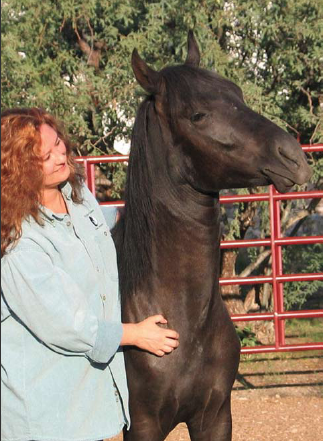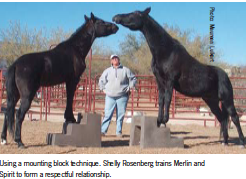In the wild, horses “do it” without any help from humans. But it’s a different story for domesticated equines. Over the years, we’ve interfered with the breeding process more and more, for various reasons. But holistic stallion breeding has begun picking up momentum, as some breeders allow stallions go back to breeding mares in a more natural manner.
As I define it, holistic stallion breeding occurs when a stallion lives with his mares and mates without direct human intervention. This is possible in a domesticated setting, but it takes some initial monitoring and training to make sure the stallion is appropriately socialized. Most stallions I’ve encountered are weaned suddenly at around six months, and isolated thereafter. Since they aren’t socialized with other horses, they don’t understand how to respect boundaries; they don’t pick up on subtle stress cues from other horses, let alone know how to defuse a situation that’s escalating.
A smaller percentage of stallions are turned out with other colts for a year or two after weaning, which gives them some experience in a herd. But this also causes socialization difficulties. Have you ever read William Golding’s classic book, Lord of the Flies? It’s an unsettling tale of an island shipwreck where the only survivors are English schoolboys. Without adult role models, the kids become increasingly brutal, creating outrageously savage dominance hierarchies.
The same thing happens to horses, especially young stallions. When we remove them from situations where older, wiser, more settled horses have influence, colts have a hard time learning how to control their tremendous energy. They don’t know how to balance their individual drives with the needs of the herd. They can be taught these skills later in life, but depending on how long the stallion was isolated and how roughly he was treated by humans in his past, it can sometimes be a hair-raising experience.
Running interference
Safety, efficiency and economics are the primary motives for interfering with the breeding process, since the more mares a stud breeds the more money he makes for his owners. I’m not against people making money in the horse business, and I think it can be done with integrity, but I’m relieved that artificial insemination has been perfected because I think it’s much kinder to the mare in many circumstances.
There’s also some risk to the stallion in any breeding situation, as a mare can mortally injure a stud with a well-placed kick – something she’s much more likely to do when she’s pressured into a situation against her will – and time is always of the essence at large breeding operations. In turn, stallions who aren’t properly socialized can be quite brutal to the mares.
Holistic Stallion Breeding
Holistic stallion breeding initially involves more time and training. It’s also unrealistic if you’re marketing a stallion to large numbers of mares who come and go. Temporarily throwing a bunch of mares together in a pasture is risky in itself, as they can injure each other under the stress of a constantly changing herd dynamic. Herds need time to develop a stable social system.
However, if you’re at all interested in holistic health and “natural horsemanship” in the truest sense of the term, I believe you must take the horse’s mental, emotional and social health into consideration. For a stallion, there is no more natural or satisfying relationship than the one he establishes with his mares. Stallions also recognize their foals, and treat even stud colt sons with much more patience and understanding than they do unrelated horses.
A question of safety
Some breeders say traditional breeding methods are safer for horses, particularly valuable horses. But a stallion who lives with a small herd can come and go, so pasture breeding does not preclude showing, training or breeding larger numbers of “guest mares” in a more time-efficient traditional way. It’s possible to strike a happy medium between marketing your stallion and allowing him to live a satisfying life. And a stud who knows how to live with and breed mares on his own is much kinder, calmer and more respectful when it comes to teasing and breeding mares he may have only a brief encounter with. So it’s a win-win situation for everyone. The only drawback, as far as I can see, is the time it takes for traditionally minded breeders to learn something new, or perhaps the temporary expense of hiring a consultant experienced in preparing a horse for pasture breeding.
There’s some risk involved with holistic stallion breeding, but I don’t believe it’s any more significant than the risk people take when leading a mal-socialized stud to a frightened, angry mare he’s just met. But people with valuable horses want as much control as possible. To avoid possible kicks, bites and nicks, many high end show horses – stallions, mares and geldings – are kept in isolated stalls and never turned out with others. I don’t think the situation is going to change any time soon, at least with horses in their prime. But there is the potential for breeders to make a foray into pasture breeding when these same horses retire from the show circuit. My stallion Merlin is a good example.
 Getting started – the experienced stallion
Getting started – the experienced stallion
Merlin had been bred in hand by previous owners. He was used to meeting mares only when they were in heat, literally jumping on them moments later. To alter this conditioning, it was very helpful to turn Merlin and his mare Rasa out in adjoining corrals so they could relate over the fence, initially when Rasa was not in heat. That way, she tended to walk away if he got too aggressive. When she came into heat, I supervised these encounters more closely with a longe whip, directing Merlin to back off if he got too feisty, so he learned that even off lead I was still part of the process. This also helped Rasa gain confidence in me as her advocate.
The first time we bred them, we used a more traditional technique. I held Rasa, but because we had formed a strong and trusting relationship, I was able to do so without hobbles or a twitch. I brought in an experienced stallion handler to lead Merlin, and we made sure he knew to back off from Rasa on command. After the initial mating, we immediately turned them loose together under supervision.
Rasa was amenable to mating off lead several times that day, but really couldn’t handle Merlin’s intense, relentless fixation on her for longer than a couple of hours. After her first colt, Spirit, was weaned, and we were in a position to have more foals, I found that Rasa was only amenable to living with Merlin full time when another mare was part of the equation. Rasa and a younger mare, Comet, were already pastures mates. They actually tag teamed Merlin, protecting each other and running him off together if he got too much for them. And with two mares in his pasture, Merlin’s attention was divided between them, so his intensity toward either one was significantly reduced. For this reason, I highly recommend pasture breeding with more than one mare. It really helps if the mares form a stable relationship of their own prior to introducing the stallion.
Later, trainer Shelley Rosenberg discovered another useful technique for introducing stallions to other horses. By that time, Merlin was around 20. We wanted to keep his body and mind in shape while fostering an attentive, cooperative attitude. Ground work included various forms of leading and longing. Shelley, who studied with dressage legend Chuck Grant and worked with stallions at a number of large breeding operations, had learned some horse tricks over the years. She easily taught Merlin to climb stairs and stand on a mounting block. This simple maneuver proved very useful in teaching Merlin self-control in the presence of other horses. Starting with a horse Merlin already knew, Shelley taught the stallion to stand on the block while she longed Rasa around him, and vice versa. When we introduced him to Comet, both stallion and mare touched noses for the first time off lead while standing on carefully positioned blocks. We’ve also used this technique in introducing two stallions to each other.
The young stallion
Preparing Spirit to breed was another story. I didn’t have the budget to buy two new mares for him, and unlike Merlin, Spirit was a virgin. It would have been nice if I’d been able to bring in an older brood mare to teach Spirit what was expected of him, but circumstances instead brought him a maiden mare named Panther.
Spirit had one huge advantage – he’d been socialized by other horses. He’d been weaned slowly at one year, the age at which mustangs tend to wean their foals in nature. He’d continued to work with his mother up to age three, and his father up to age four. He’d also had a stud colt friend to play with for awhile, and had lived with a group of older geldings.
 By this time, we’d built some spacious corrals to allow stallions to be exposed to other horses 24 hours a day. Consisting of sturdy steel fencing with 5’-wide aisles between, these enclosures provide space for horses to cavort together without being able to touch, kick or bite each other. We put Spirit and Panther in two of these corrals right next to each other. At age five, Spirit was feisty. Even though he couldn’t touch Panther, he was initially so intense that he managed to intimidate his future mate to the point where she didn’t go into heat for six weeks – at the height of the breeding season!
By this time, we’d built some spacious corrals to allow stallions to be exposed to other horses 24 hours a day. Consisting of sturdy steel fencing with 5’-wide aisles between, these enclosures provide space for horses to cavort together without being able to touch, kick or bite each other. We put Spirit and Panther in two of these corrals right next to each other. At age five, Spirit was feisty. Even though he couldn’t touch Panther, he was initially so intense that he managed to intimidate his future mate to the point where she didn’t go into heat for six weeks – at the height of the breeding season!
Shelley and I worked as a team to train Spirit to calm down and respect Panther’s boundaries. With Shelley leading Spirit and me leading Panther, we taught the pair some approach and retreat techniques. Even more specifically, we taught Spirit to pause, rock back slightly and breathe deeply whenever Panther showed signs of stress on his approach. I began to see Spirit do this of his own accord when they were in their corrals, and he could actually get her to join up with him at a distance. When this happened, Panther immediately went into heat.
The first time, we bred them on lead lines with no restraints on the mare. Then we turned them loose together. They were still a bit like two teenagers fumbling around in the back seat of a car, and needed some assistance for various reasons. For instance, being a maiden mare, Panther didn’t realize she was supposed to stand still during mating. She’d walk around with Spirit in full mounting position. With a little more coaching, they were able to mate and live together on their own within two days.
When you take the time to raise horses more naturally and engage in holistic stallion breeding, you save untold hours in training time further down the road. The horse is more secure and willing to be your partner when you prove you’re taking his mental, emotional and social needs into consideration.
Linda Kohanov is a trainer, clinician, and best-selling author of several books, including the 2001 classic The Tao of Equus. She offers more in-depth narratives of her adventures in natural breeding in her 2003 book Riding between the Worlds and her book/horse wisdom card kit Way of the Horse, a collaboration with noted equine artist Kim McElroy. As founder/director of the Epona International Study Center and Equestrian Retreat in Arizona, Linda and trainer Shelley Rosenberg also offer workshops and private consultations. For more information, visit www.taoofequus.com or call 520-455-5908. Photo: Kevin Anderson Merlin bonds with Panther.









